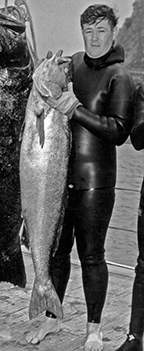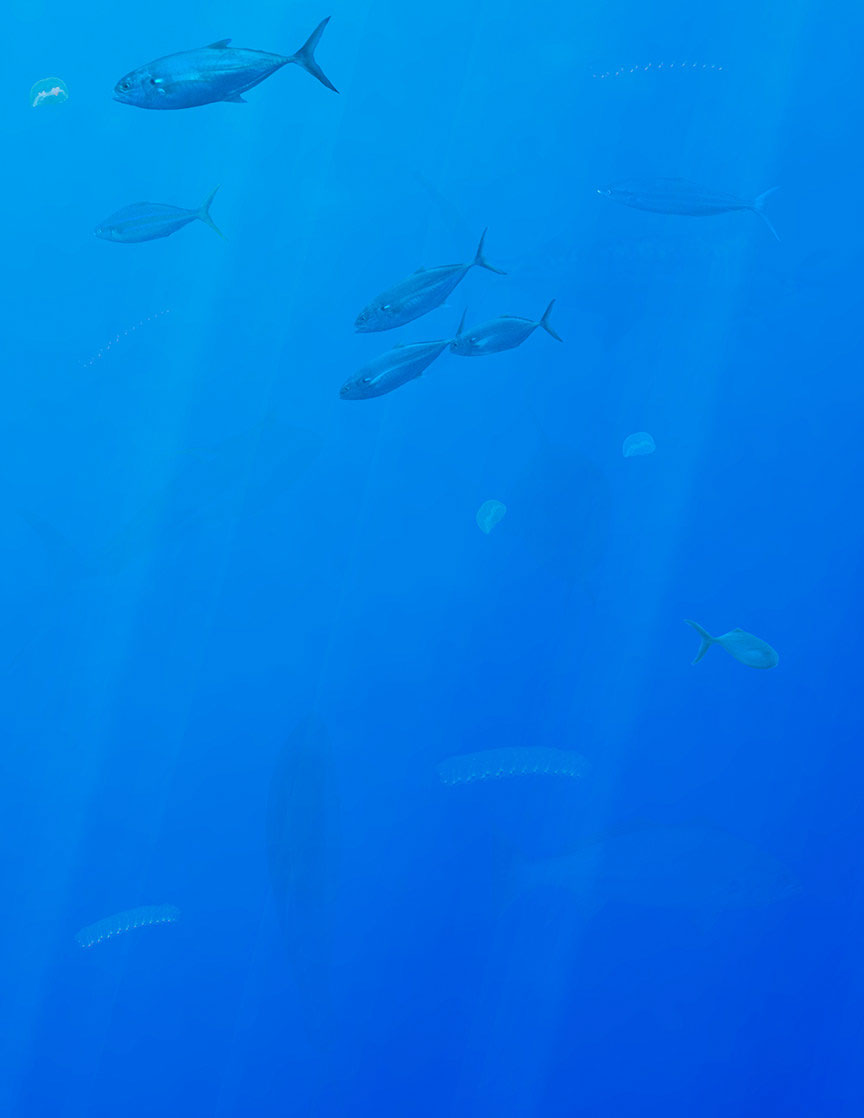
|
 |
Copyright © 2005 Terry Maas, BlueWater Freedivers
BLUE WATER HUNTING—THE KEYS: ENTHUSIASM, SENSES, MEMORY
Its been nearly 40 years now, but I can
still remember the excitement of diving with my friend and mentor Al Schneppershoff Sr.
For a Northern California boy, thoughts of diving off of exotic Southern California
islands conjured visions of clear water and trophy fish lurking in the cathedral-like
80-foot kelp forests below. Al took me to his favorite locations: Italian Gardens,
Sid’s Outside, Little Gibraltar and Al’s Funky Kelp Bed.
Al always doubled the catch of anyone on the boat. I’m not sure if even Al could tell
you the reasons for his successes. As much as I wanted to charge off into the blue alone,
I forced myself to spend some time studying Al’s ways. I distilled his champion
essence into 3 components: 1) enthusiasm; 2) observation—sound/sight; 3) and memory.

(enlarge)
Every summer weekend offered an expedition
to Catalina or the Channel Islands in search of “big game.” Al’s enthusiasm
for blue water hunting was so intense that he considered Monday as simply the beginning of
5 days to endure before his next adventure. He dreamed, as we all do today, of the perfect
day in the blue…
Swirling bait schools, jumping tuna crashing through wave crests, screeching birds diving
and purple shimmering scales torn from the bait by marauding game all signal your quarry
is near. Visions of sleek blue water fish fill your imagination as you try to control your
racing heart and cramping bladder. Leaving the terrestrial world behind, you tip over and
submerge to meet the ocean’s sleekest fish on their terms.
Your senses drink in the liquid blue. The enveloping, supporting water transmits
temperature changes to your skin. Fish appear and disappear with such speed that you are
unsure of what you actually saw. Sounds are everywhere from the thunderous explosion of a
pelican diving onto a school of bait inches from your head to the faint, haunting melody
of a passing whale.
Bait fish under attack telegraph their fear. Sometimes you’ll hear a single
synchronous boom of thousands of small tails beating as one unit. At other times, a
cascading wave of sound lasting several seconds echoes through the water as fleeing fish
create a domino-effect where one scared group panics another, hundreds of feet away. Even
though you have not seen the game, its presence is clear.
In California, we often hunt white seabass by sound. We’ll swim through acres of kelp
forest listening intently for their characteristic croaks against the background sounds of
rock-shrimp and pebbles rolling in the surf. When I hear the first sound, I’ll
immediately stop swimming and wait for another verifying croak to distinguish it from a
sound I may have accidentally made. I’ll quickly mark the spot with shore bearings
and start swimming in 4 cardinal directions to localize the sound. I know I’m getting
close when the croaks become louder. When the sound is so intense that it physically
vibrates and resonates in my chest, I know the fish is probably within a few feet of me.
When I finally spot the shy white(s), my senses focus and I sear the memory of the event
into my brain. I’m sure that’s what Al did.
Watching Al swim off, I could tell he was familiar with his surroundings as he morphed
from an overweight land animal into a sleek seal. After years of sightings, Al could tell
by the visibility, currents, temperature, bait and time-of-day where he was most likely to
encounter game. His famous “fish sense” was based on years of data stored in his
keen enthusiastic mind from which he instinctively drew successful conclusions about fish
behavior.
When Al reported more fish sightings than anyone in the area, I realized that he had
perfected his underwater vision to such an extent that what Al “saw” was not the
obvious fish 5 feet away but rather glimpses of shapes and colors so indistinct and subtle
that only an experienced diver could decipher these faint apparitions as fish.
Many game fish adopt the coloration of their surroundings. The most famous is the
swordfish. Time and again, divers have reported seeing the great fish’s fin topside
just ahead on the surface simply vanish when they ducked underwater. It’s as if their
skin sends out a cloaking bioluminescence the exact shade and color of the surrounding
water allowing it to disappear. White Seabass turn almost white against a sand bottom and
silver high in a column of greenish water. The often kaleidoscopic dolphin fish (dorado)
can become a drab steel-gray exactly matching the shade of the ambient water.
Often it is only an outline we see that gives the fish’s presence away. Furthermore,
it’s not generally a perfect profile but rather a partial profile we see as only part
of the fish is visible and frequently that part is oriented in an odd attitude. The most
difficult profiles to spot are straight-away, straight ahead, directly below and oblique.
Often a spot or streak of color draws your attention first and after intently focusing the
faint outline appears. My memory of my 256-lb record yellowfin was representative of an
unusual initial presentation. At the edge of the visibility, about 60-feet away 4, oval
beach balls appeared at my level. I was 25
feet down and the giants were swimming directly toward me. I had plenty of time to slowly
position my gun in the general direction as the balls slowly developed the eyes and mouths
of tuna.
TO REVEAL THE HIDDEN
FISH--ROLL YOUR MOUSE OVER IMAGE...(WAIT A SECOND OR TWO)

Subtle motion often helps you make out the profile of game fish in the distance. With
practice, your eye will discriminate movement—what appears to be a far off curved
string of jelly fish can quickly morph into the disappearing yellow finlets of large tuna.
When you detect motion, stop your scan for a few seconds and try to find the reason for
the movement.
One of the best reasons for spotting game early is that you have time to slowly reposition
yourself in their path so you do not have to make a snap shot. It’s also a good self
defense technique for spotting sharks! Sighting fish at the edge of visibility also helps
to keep you alert and engaged in your surroundings. Spotting the faint image after hours
of diving instantly cancels your fatigue, grumbling stomach or chilled body as adrenalin
surges keep you focused and pumped for hours. When you get bored and lose attentiveness,
your vision naturally settles to a focal point about 18 inches from your mask, which makes
it difficult to distinguish fine detail at the edge of visibility many feet away. You can
counter this lazy-eye tendency by actively picking out objects in the distance—small
bait, jelly fish or flotsam.
Only rarely in blue water hunting is the action heavy and sustained. Many days I’ve
spent 6- to 8-hours swimming in the blue without a single sighting. Sometimes, if I
don’t see any hints of game, I’ll dredge a sighting from memory with similar
conditions. This technique keeps me engaged in the hunt and helps remind me of the subtle
hints I’m looking for. One way to sustain your enthusiasm is to constantly tell
yourself that the “big one” will appear on the next dive.
While we all enjoy hunting in boundless blue visibility, we often find ourselves slogging
around in green water, which offers limits to our vision with indistinct boundaries. The
subtle hints of fish are even more difficult to discern. Because of our restricted vision
in the green water, our reaction times and setup times are short. About the only advantage
green water offers—and sometimes it is a very real advantage—is that when you
finally see game, they are usually very close and generally within range of your spear.
It all starts with enthusiasm. Be like Al. Spend lots of time in the water and record your
impressions deeply into your memory. Eventually, you’ll create a valuable resource,
almost an instinct, for evaluating conditions and for sustaining your focus and
attention—attributes which are critical for hunting and survival in the blue water
environment.
Copyright © 2005 Terry Maas, BlueWater Freedivers
|